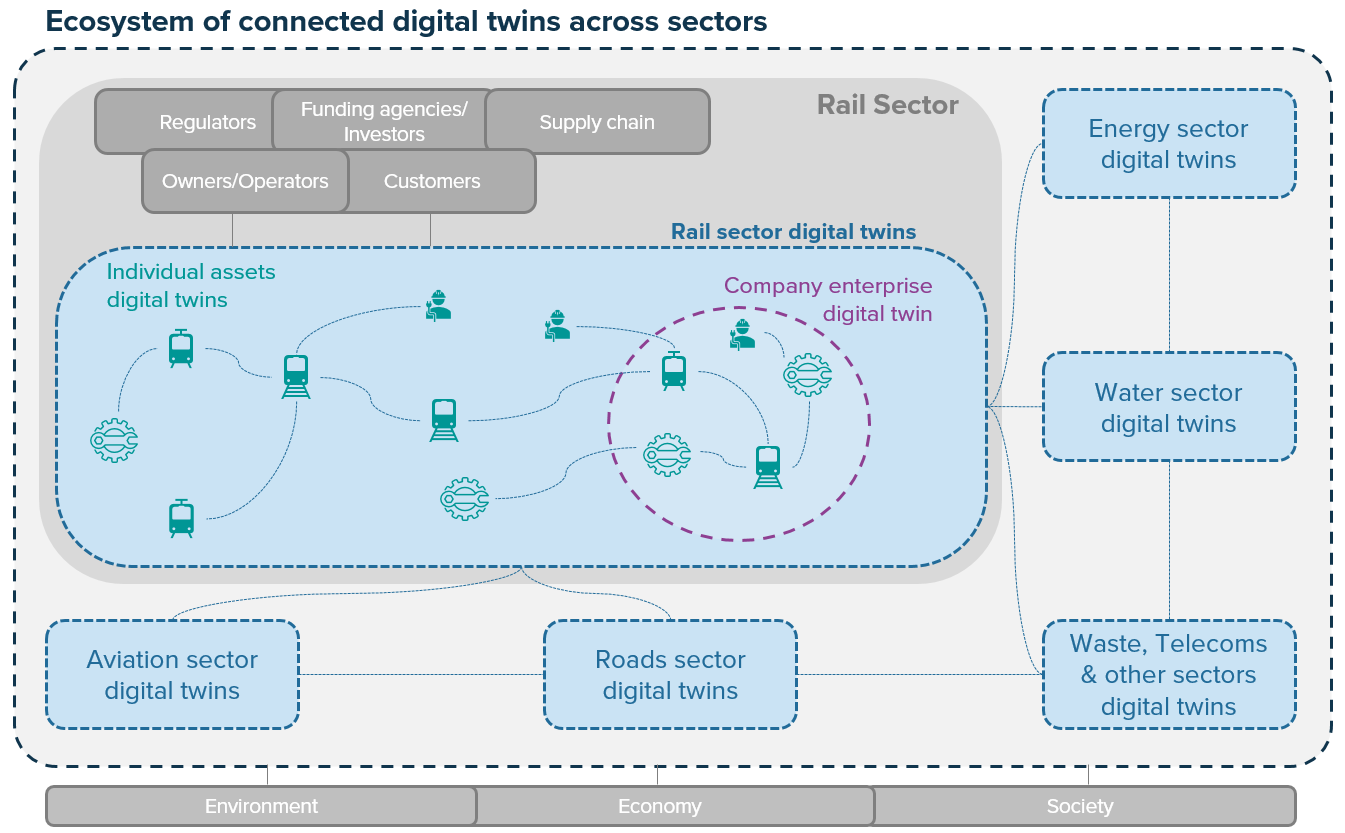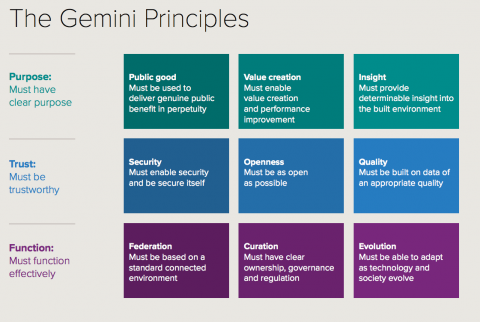The Rail Sector and the National Digital Twin
Web of digital twins in rail
The rail sector is a complex network of assets and systems that come together to enable people and goods to travel safely, in a timely way at various speeds and distances.
As digital twins emerge they must extend beyond individual assets, and into the systems they are part of. For example, a digital twin of a maintenance yard (the individual asset) should integrate within a digital twin of the rail system (the rail enterprise system). Such integration would allow the owner to test scenarios, manage and optimise interventions, in terms of maintenance and the introduction of new capital assets. An enterprise digital twin optimises the performance of individual assets, as well as the system holistically. Recent examples of digital twins in the rail sector include, Greater Anglia and Toshiba use of digital twins to improve timetabling or the West Coast Mainline Network Digital Twin for maintenance decision support. In addition, many organisation are investigating the benefits of digital twins at an organisation level, for example, SNCF ‘The digital twin’ campaign.
Facilitated by the digital revolution, there is a huge opportunity to create a federated web of digital twins from individual assets and enterprises. This will propel the digital maturity of the rail sector and acknowledge that the rail sector is not isolated from others. More specifically, other sectors it interfaces with include roads and airports, the energy grid, telecommunication networks, parking lots and commercial buildings.

Figure 1: National Digital Twin (from a rail perspective) – an ecosystem of connected digital twins that share data securely and effectively to enable better services and products for all stakeholders.
A web of interoperable digital twins would enable multi-system physical interventions and optimisation across the sector. This holistic multi-system approach facilitates a new revolution in scheme optimisation and infrastructure planning, driving a significant productivity gain to the nation’s economy. For example, it would be possible to assess the impact of a new railway on all associated infrastructure systems so stakeholders can maximise the desired outcomes on factors such as congestion, economic growth, mobility, and air quality. Furthermore, a web of interoperable digital twins could have the potential to reduce incidents and expose financial risks on the basis of health and safety at individual assets.
What is needed
The relationship between the digital twin and its physical counterpart is two way and dynamic—data comes in followed by interventions going out if appropriate. Loading the right amount of data at the right time is essential to ensure that an individual digital twin serves its purpose. Some digital twins require millisecond updates (locations of high-speed trains) but others may only need updating every few days or months (low wear maintenance components such as brake blocks). Therefore, an information architecture is required that enables integration of digital twins operating at different levels (i.e. different granularities in space and time). This will allow effective and secure exchange of information, without alterations to the purpose of the individual digital twins.
Developing such information architecture requires a huge amount of effort and innovation. Which is why collaboration between organisations towards a shared long-term vision while jointly prioritising focus in the short-term is the best way forward.
A working group of information management experts facilitated by the NDT programme identified a technical core to enable the integration of digital twins. This is known as the technical core or the Information Management Framework (IMF) which consists of:
- Foundation Data Model (an upper ontology)
- Reference Data Library (a federation of consistent Reference Data Libraries)
- Integration Architectures (to facilitate interoperability and linkage of digital twins).
National Digital Twin Programme
The NDT programme envisions an ecosystem of digital twins joined through a standardised protocol, the IMF. Through this ecosystem information will be shared securely, effectively, and as required benefiting society, the economy, and the environment.
The National Infrastructure Commission’s seminal Data for the Public Good report recommended the creation of a NDT. As a result, the NDT programme was established by the Centre for Digital Built Britain (CDBB) to facilitate and steer the development of the IMF which underpins a NDT.
The programme brings together industry, academia and government to facilitate the development of the NDT. So far, the NDT programme has delivered:
- Gemini Principles: setting out the proposed principles to guide the NDT and the information management framework that enables it (figure 2).
- Information Management Framework Roadmap: a prioritised plan for five core streams responsible for the delivery of the information management framework.
- Digital Twin Hub: a collaborative web-enabled community for those who own or are developing digital twins.

Figure 2: The Gemini Principles developed by the CDBB
Recommendations
The National Infrastructure Commission found that digitising the rail network’s asset information could save £770M over the next 8 years in the UK. Four recommendations for immediate actions are proposed to advance digital twins and unlock their benefits:
1. Adopt the Gemini Principles in your digital strategies: CDBB is calling on leaders involved in creating and building the Gemini Principles into their digital strategies. The principles enable a values-based approach for the development of digital twins and alignment for organisations.
2. Assess and upskill digital capabilities: The changes brought by the digital revolution is driving a need for new services across the rail industry, such as cyber resilience, data science, data modelling, software development and more. Organisations should assess digital capabilities and upskill as required to ensure a productive network that is fit for the future.
3. Open data to unlock its value: Open data does not mean that everyone has access to your data, but it means data is shareable within an organisation, their supply chain and other organisations in the rail network. According to the Gemini Principles, data must be as open as possible while remaining consistent with the principles of holistic security to create maximum value for everyone.
Gartner Inc. recommends that organisations should:
- Include data from many sources: expand the use of digital twins by recommending that information technology architects and digital twin owners define an architecture that allows access and use of data from multiple sources.
- Ensure long access life cycles by avoiding proprietary software.
4. Collaborate: Learn by doing and progress by sharing. There are many digital twins communities emerging, such as the Digital Twin Hub and the Digital Twin Fan Club. Joining such communities will facilitate and support sharing success stories, knowledge, lessons learned and connect you to others involved with digital twins.
Article by Peter El Hajj of Mott MacDonald and Programme Manager on the National Digital Twin Programme

